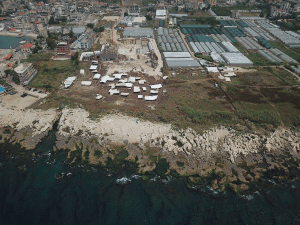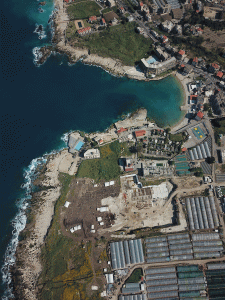Marine exploitation, seafaring and cultural diffusion in Tabarja Wata Slam 100 (TWS 100), a Neolithic site on the Lebanese coast - ongoing
Corine Yazbeck
 The Neolithic of Lebanon is poorly known when compared to adjacent countries; most recorded sites consist of find-spots where no stratigraphy was recorded. Few sites have been excavated and these are Tell Labwe south Nachcharini in the Beqaa and Byblos on the coast. In fact, Byblos was the only site where extensive excavations were undertaken. The Neolithic of Byblos is a pottery Neolithic and no Pre-pottery evidence was recorded. Consequently, TWS 100 represents the only site on the Lebanese coast (and possibly on the Levantine coast) with a sequence covering the Middle PPNB, the Late PPNB and the pottery Neolithic.
The Neolithic of Lebanon is poorly known when compared to adjacent countries; most recorded sites consist of find-spots where no stratigraphy was recorded. Few sites have been excavated and these are Tell Labwe south Nachcharini in the Beqaa and Byblos on the coast. In fact, Byblos was the only site where extensive excavations were undertaken. The Neolithic of Byblos is a pottery Neolithic and no Pre-pottery evidence was recorded. Consequently, TWS 100 represents the only site on the Lebanese coast (and possibly on the Levantine coast) with a sequence covering the Middle PPNB, the Late PPNB and the pottery Neolithic.
Before the discovery of TWS 100, it was thought that the Neolithic expansion started from the Damascus basin through the Beqaa and later on towards the coastal area. The substantial data gathered so far from TWS 100, strongly suggest it predates Tell Labwe south in the Beqaa, considered as the earliest Neolithic village in Lebanon. As confirmed by radiocarbon dating, the earliest occupation of the site dates back to 8960 ± 150 BP which corresponds culturally to the Middle PPNB. It is important to note that the Middle PPNB is a crucial phase of the Neolithic where evidence of crop cultivation and herding appeared.
 In addition, the specific location of the site on the coast added to the nature of the data uncovered so far raises many questions regarding the relation between the Neolithic settlers and the sea not only as a natural resource of food (fish and molluscs) but also as a channel for the diffusion and expansion of culture and inventions (marine seafaring, agriculture, domestication); a possible expansion towards Cyprus via maritime routes is one of these issues.
In addition, the specific location of the site on the coast added to the nature of the data uncovered so far raises many questions regarding the relation between the Neolithic settlers and the sea not only as a natural resource of food (fish and molluscs) but also as a channel for the diffusion and expansion of culture and inventions (marine seafaring, agriculture, domestication); a possible expansion towards Cyprus via maritime routes is one of these issues.
This research has several objectives; the first one consists of exploring the various aspects of the interaction between the occupants of TWS 100 during the Pre-Pottery and the Pottery Neolithic and the sea through a multidisciplinary approach. The second one consists of understanding the role of the site and therefore of the Lebanese coast in the development and the diffusion of the Neolithic lifeways (crop cultivation and animal husbandry) throughout the Levant. Part of this objective would be to understand the role of Tabarja as a harbour site for navigation linking the continent with the Mediterranean islands such as Cyprus. The third objective is to reconstruct the interaction between the continent and the islands inhabitants through the analysis of specific aspects such as the domestication of goats and swine and their introduction through maritime routes to the islands such as Cyprus.
More information about the work undertaken here by the HFF Lebanon team can be found here.
2023 Final Report
Tabarja Wata Slam 100 (site code TWS100) is a major pre-Pottery and Pottery Neolithic settlement on the Lebanese coast, located 28 Km North of Beirut and 11 Km South of Byblos. The site’s occupation spans the Middle and the Recent PPNB as well as the Pottery Neolithic (from 8164 Cal bC to 6593 Cal bC ) making it a key site for understanding early farming and fishing communities on the Eastern Mediterranean coast . We investigated aspects related to marine exploitation, seafaring and cultural diffusion through a multidisciplinary approach involving the study of a stratigraphic sequence from sector B3 . Our approach involved the study of the main components where team members were able to bring substantial data on the relation of the TWS100 settlers with the sea, their subsistence economy, as well as their believes.
The detailed analysis of the stratigraphy of B3 has confirmed the four stages of development previously recognized; this will be strengthened by an additional set of 5 Radiocarbon dates (ongoing, see Yazbeck et al 2020).
In relation to maritime activities the selected area in sector B3 provided 2 anchors as well as 10 weights; the coastal location of the site and mostly the halieutic activities that are well-evidenced – by the fishing weights, fish hooks and ichtyofaunal remains discovered – indicate that they were undoubtedly fishing crafts. The stone anchors and weights represent a unique cultural heritage which bears witness to the major maritime activities that are fishing and seafaring in Tabarja, and more widely in Lebanon and the Levant, during the Neolithic.
In relation to the ssubsistence economy, TWS100 settlement may be considered as one of the earliest domestication localities recorded on the coastal Levant and may have contributed to the transfer of these animals to the island of Cyprus. It is supplemented by strong activities of deep-sea fishing with the presence of tuna, triggerfish, seabream and groupers. The preliminary analysis of shellfish indicates that the inhabitant of the site equally exploited the offshores and deep water zones in order to gather marine bivalves for ornamental and artefacts. On the other hand, botanical remains have revealed a botanical diversity dominated by cereals and pulses where fruits and nuts are also present. Hence, it is a mixed economy based on livestock husbandry, hunting, gathering and fishing similar to the economy of a typical Mediterranean fishing village identified on the coast of the southern Levant during the PPNC and the Pottery Neolithic (PN) with the exception of the pig exploitation. These preliminary results on the PPNB settlements of TWS 100 support the hypothesis of a micro-regional diversity in the development of Neolithic subsistence strategies in the Levant.
Our future plans include the publication of this study and the study of the main components throughout the whole sequence in sectors A, B and C from TWS100.
